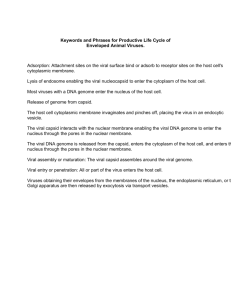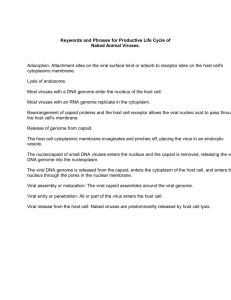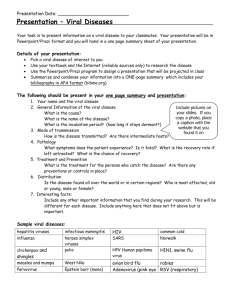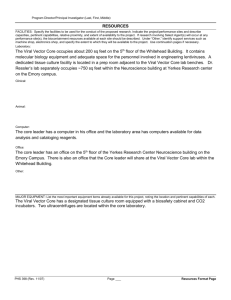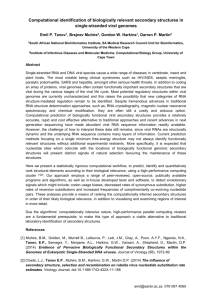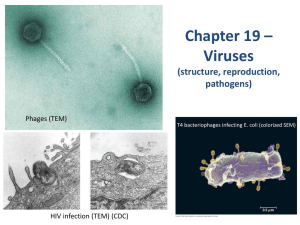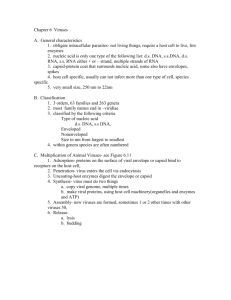Viral size and organization
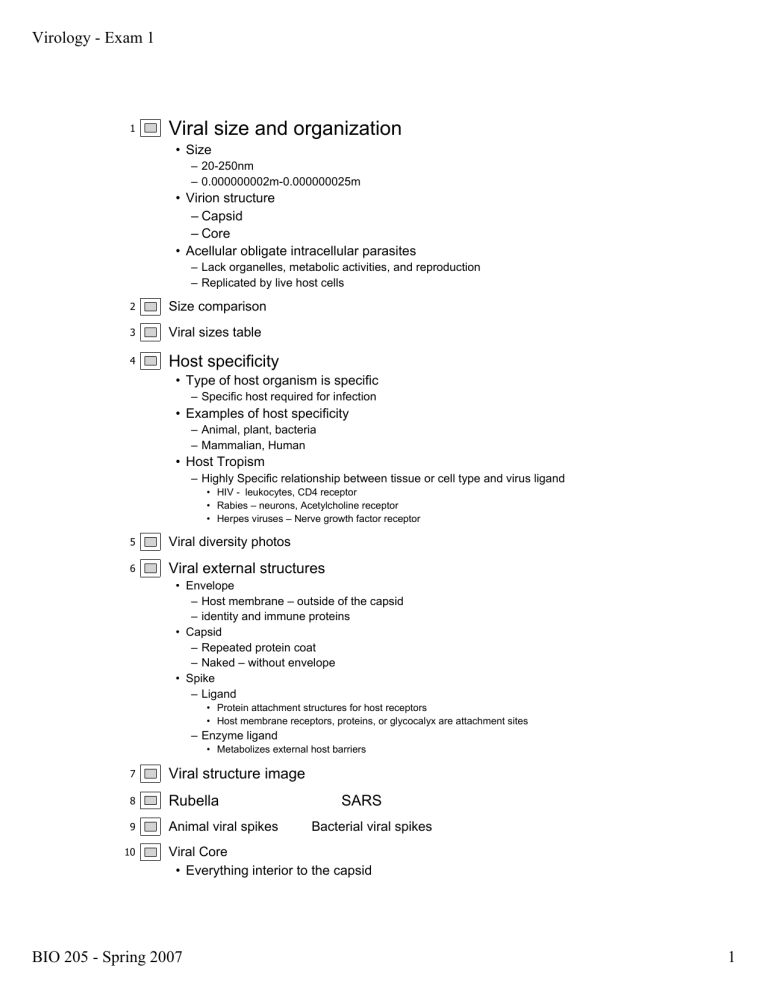
Virology - Exam 1
5
6
7
8
9
10
2
3
4
1
Viral size and organization
• Size
– 20-250nm
– 0.000000002m-0.000000025m
• Virion structure
– Capsid
– Core
• Acellular obligate intracellular parasites
– Lack organelles, metabolic activities, and reproduction
– Replicated by live host cells
Size comparison
Viral sizes table
Host specificity
• Type of host organism is specific
– Specific host required for infection
• Examples of host specificity
– Animal, plant, bacteria
– Mammalian, Human
• Host Tropism
– Highly Specific relationship between tissue or cell type and virus ligand
• HIV - leukocytes, CD4 receptor
• Rabies – neurons, Acetylcholine receptor
• Herpes viruses – Nerve growth factor receptor
Viral diversity photos
Viral external structures
• Envelope
– Host membrane – outside of the capsid
– identity and immune proteins
• Capsid
– Repeated protein coat
– Naked – without envelope
• Spike
– Ligand
• Protein attachment structures for host receptors
• Host membrane receptors, proteins, or glycocalyx are attachment sites
– Enzyme ligand
• Metabolizes external host barriers
Viral structure image
Rubella
Animal viral spikes
SARS
Bacterial viral spikes
Viral Core
• Everything interior to the capsid
BIO 205 - Spring 2007 1
Virology - Exam 1
13
14
15
16
11
12
19
20
17
18
21
• Single RNA or DNA chromosome
– Ranges from 4 to 200 genes
– RNA viruses subject to rapid mutation changes
• Core enzymes – RNA viruses
– Nucleic acid polymerase enzymes
• attached to the chromosome to initiate replication of new chromosomes
Viral core enzymes
Viral classification or naming
• Historical
– Pox, influenza, measles, herpes
• Mode or source of transmission
– Arbo = forest > insect transmitted
• West Nile Virus
• Dengue Fever Virus
• Clinical properties
– HIV, SARS, encephalitis, hepatitis
• Anatomical or Physical properties
– Chromosome type - DNA or RNA
– Size and appearance
• picorna (polio), corona (SARS)
ArbovirusTransmission mode
Arboviruses
Arbovirus disease map
Medically important DNA viruses
• Pox
– Small pox (variola)
– Cowpox (vaccinia)
– Monkeypox
• Herpes
– Cytomegalovirus (CMV)
– Epstein-Barr
– Varicella (chickenpox)
– HSV1,2
• See DNA virus Table
Medically important DNA viruses
Child with Smallpox photo
Hepatitis B particles HepB Pathology
Herpes Simplex 1 virus HSV1 lesion
Medically important RNA viruses
• Picorna – Polio, HepA, Rhino
• Paramyxo – Rubeola, Mumps, RSV
• Toga - Rubella - Adult or German measles
• Flavi – Hep C
BIO 205 - Spring 2007 2
Virology - Exam 1
29
30
31
32
33
34
24
25
22
23
26
27
28
• Retro – HIV, HTLV
• Rhabdo
• See RNA viruses Table 1 and 2
Medically important RNA viruses table 1
Child with Polio paralysis photo
1930-40’s Polio epidemic
Medically important RNA viruses 2
Viral replication events overview
• Attachment and Entry
– Uncoating of capsid from enveloped viruses
• Replication
– Chromosome
– Capsid
• Assembly and Release
– Inside host cell
– On membrane
Viral replication model image
Viral Attachment and Entry
• Three modes
• Adsorption – naked viruses
– Capsid or spike proteins attach to host membrane
– Viral plasmid admitted into cell
– Capsid remains external
• Fusion - enveloped
– Envelope spikes attach to receptors and fuses with host membrane
– Capsid admitted into cell
• Receptor-mediated endocytosis - enveloped
– Envelope spikes attach to host membrane receptors
– Endocytosis response
– Entire enveloped virus admitted into cell
Viral Entry modes image
Naked virus Entry
Enveloped virus Entry
HIV receptor attachment image
Endocytosis entry into host photo
Influenza spikes
• Two step entry
• Neuraminidase
– Enzyme ligand
– digests host glycocalyx
• Hemagglutinin
BIO 205 - Spring 2007 3
Virology - Exam 1
35
36
37
38
39
40
41
42
– Attachment ligand
– Growth hormone receptors
Hemagglutination
Used to ID viruses with hemagglutinin
Viral Plasmid Replication
• Plasmid is uncoated from capsid
• Viral plasmid copies are made
– Viral core enzymes initiates replication (RNA) OR
– Host cell enzymes initiate replication (DNA)
• Replication occurs in the cytoplasm or nucleus
DNA viral chromosome
• Viral DNA chromosome is used as a template to synthesize new viral DNA chromosomes
• Viral DNA > DNA synthesis > New viral DNA chromosomes
RNA viral chromosome
• Viral RNA chromosome is used as a template to synthesize new viral DNA chromosomes
– Reverse Transcriptase (RT)
• Viral DNA is then a template for new viral RNA chromosome synthesis
– Viral DNA may be a transposon in host DNA
• Viral RNA > RT > Viral DNA chromosome > Viral RNA chromosome
Lysogeny
• Genetic transformation of host
– Viral chromosome is a permanent resident of the host cell
– Viral DNA chromosome integrated into host chromosome
• Bacterial = Transposon
• Eukaryotic = Provirus
• Retroviruses
– Viral DNA chromosome stored in cytoplasm
• Plasmid
• Herpes viruses
Cell and viral chromosomes image
Viral Protein Synthesis
• Viral transcription
– Viral chromosome transcribed to mRNA
• Viral translation
– Viral mRNA translated to a large polypeptide
• Viral protein processing
– Viral polypeptide cleaved into separate proteins
• Capsid
• Spikes
• Nucleic acid polymerases
– Viral proteins folded and assembled together
Viral protein synthesis image
BIO 205 - Spring 2007 4
Virology - Exam 1
43
54
55
56
50
51
52
53
44
47
48
49
45
46
Viral assembly and release
• Viral assembly
– Spikes, Capsids and Chromsomes
• at the host outer membrane
• in the host cytoplasm
• Viral release modes
– Lytic (lysis = splitting or bursting)
• Acute
– Budding = exocytosis or secretion
• Leads to cell death
• Persistent, Chronic or Recurrent
Enveloped viral release
Enveloped virus budding
Viral budding photo
SARS viral particles in human lung cell photo
Viral release modes image
Bacterial viruses
• Bacterial viruses are called PHAGES
– Specific for certain bacteria species
– Responsible for transferring antibiotic resistance between bacteria
• Phage replication
– Adsorption is the method of attachment to host receptors
– Entry of viral chromosome (plasmid) only
Phage photo
Phage attachment and entry image
Phages attached to bacterial cell photo
Phage replication
• Lytic
– Viral assembly and release cause lysis of host cell
• Lysogenic
– Viral chromosome or plasmid is replicated and then passed on to dividing bacteria
– Lysis may occur in any generation
Phage replication and release image
Phage lysis and lysogeny image
Phage gene recombination image
BIO 205 - Spring 2007 5

